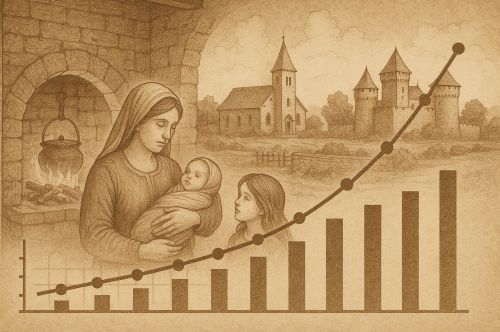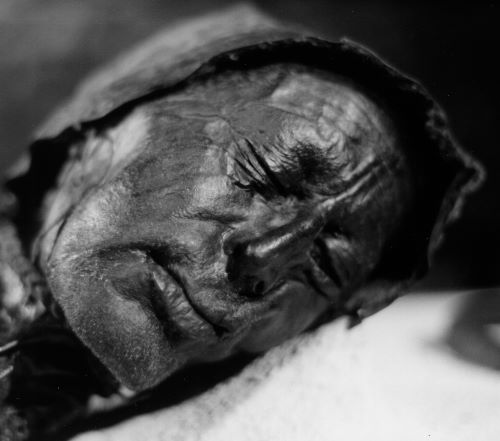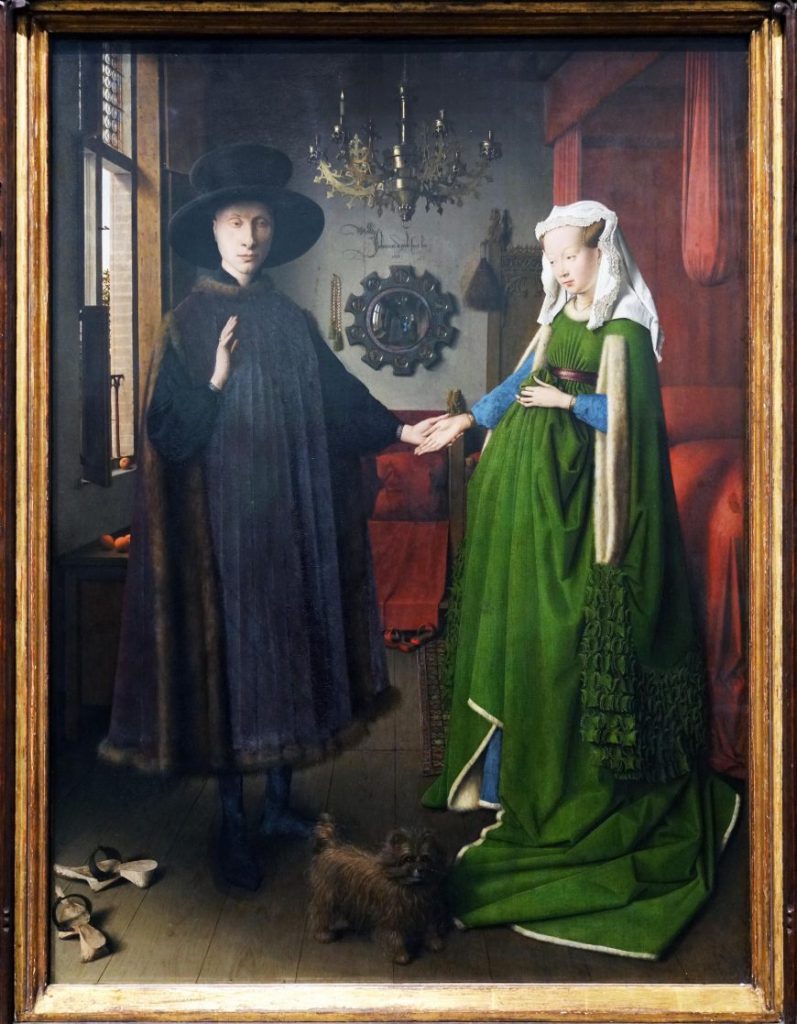

Birth rates in the medieval world illuminate the precarious balance of life before modern medicine. Fertility was abundant, mortality relentless.

By Matthew A. McIntosh
Public Historian
Brewminate
Introduction
Birth in the medieval world was a matter of both necessity and vulnerability. Fertility was celebrated, even idealized, yet the survival of infants and mothers alike was never guaranteed. Families sought to produce many children, but high mortality meant that populations often grew only slowly. For historians, the problem lies in reconstructing these rates with precision. Unlike modern censuses, medieval records are patchy, uneven, and often shaped by religious or administrative priorities.
Yet across both East and West, patterns emerge. Fertility was high, marriage norms varied, and family structures shaped demographic outcomes. To understand medieval birth rates is to understand not only population growth but also the cultural logic of lineage, gender, and survival.
Methods and Limits of Evidence

Archaeology offers one entry point. Skeletal remains from burial grounds reveal disproportionate numbers of child graves, often half or more of all interments.1 These findings suggest the fragility of life in infancy and the need for repeated pregnancies to sustain population levels.
Texts add another lens. Manorial rolls in Europe record household size, while later medieval church baptismal registers in England and Italy begin to provide glimpses of fertility.2 In the Islamic world, jurists wrote about marriage, inheritance, and procreation, while Chinese gazetteers recorded households and sometimes children. These sources rarely give direct figures, but they allow historians to infer birth rates from household composition and generational continuity.
But evidence is never straightforward. Skeletal samples may be biased toward particular cemeteries, while textual records often reflect elite concerns rather than peasant realities. The greatest danger lies in overconfidence: a claim that Florence or Song China had “x” births per woman is almost always speculative. Still, when archaeology, text, and anthropology converge, they provide patterns that, while approximate, are compelling.
Western Christendom

In medieval Europe, marriage was often delayed compared to other regions. Canon law discouraged unions before puberty, and economic pressures meant peasants commonly married only after securing land or a household. Historians describe a “Northwestern European marriage pattern” in which women wed in their twenties and men later still.3 This reduced total fertility compared to places where women married earlier.
Yet high infant mortality, often estimated at 25–30 percent, meant that women bore many children to ensure lineage survival.4 Noblewomen in dynastic families might deliver ten or more children, though only a portion lived to adulthood. Among peasants, family size was constrained by subsistence and inheritance, but once marriage occurred, fertility remained robust.
The Black Death reshaped the pattern dramatically. Mortality in the mid-fourteenth century may have halved Europe’s population. Yet in its aftermath, wages rose and land became more available. Some families married earlier, encouraging a brief fertility rebound. Others delayed marriage to consolidate resources, producing smaller households. The demographic legacy of plague was thus uneven, reminding us that fertility was always entangled with crisis.
The Islamic World and Byzantium

Marriage norms in Islamic societies generally encouraged earlier unions. Girls often married in their teens, which increased potential fertility. Procreation was framed as a religious duty, with legal writings emphasizing both marriage and childbearing.5 This framework sustained high fertility, even in contexts where survival rates lagged.
Urban and rural differences were stark. In cities such as Cairo, crowding and disease suppressed survival, particularly among infants. Rural families often fared better, with larger households and more stable fertility outcomes, though famine and war remained threats.
Byzantium occupied a middle ground. Marriage age varied by class, and while elites pursued dynastic strategies, rural populations reproduced more steadily. Monasticism reduced overall fertility slightly by withdrawing a portion of the population from marriage. Yet the empire’s family culture emphasized inheritance and continuity, reinforcing the expectation of multiple heirs.
South and East Asia

China supplies unusually detailed demographic glimpses. Tang and Song registers recorded households for taxation, offering indirect evidence of fertility. Confucian ideals of lineage continuity, especially through sons, created strong pronatalist pressures.6 Women often married young, producing high potential fertility. But mortality (through famine, epidemic, or war) cut into realized growth.
The Song dynasty demonstrates this tension vividly. Agricultural expansion allowed population growth, but eleventh-century epidemics and twelfth-century warfare checked it repeatedly. Fertility was high, but stability fragile.
In India, early marriage was common, often before twenty. Hindu and Buddhist texts stressed the virtue of large families, while practical constraints such as dowry and inheritance shaped real outcomes. Periodic famine regularly pruned demographic gains.
Japan presents yet another pattern. Among the Heian aristocracy, fertility was tied to court politics and inheritance maneuvering. Women bore multiple children, but infant mortality was high. Later medieval Japan saw rural fertility shaped by cycles of famine and civil war. Across Asia, the unifying rhythm was one of high fertility potential consistently eroded by external shocks.
Structural Constraints on Birth Rates

Nutrition dictated fertility. Poor harvests could delay menarche or suppress menstruation, lowering birth rates. Famine might reduce conceptions for several years, while abundance often produced fertility rebounds.
Child spacing mattered. Breastfeeding delayed conception through natural infertility, often creating two- to three-year gaps between children.7 Religious restrictions reinforced spacing: Catholic prohibitions during Lent or postpartum abstinence in Islamic law. Contraception was rudimentary but present, with withdrawal and herbal methods sometimes employed. Infanticide, though condemned, occasionally served as a grim form of control.
What emerges is not uniform high fertility but patterned rhythms. Periods of stability produced multiple births per woman; times of hardship curtailed fertility through both biology and behavior.
Comparative Reflections
Europe’s delayed marriage reduced total fertility, while Asia’s earlier unions maximized reproductive spans. Yet both regions were bound by the same constraints of mortality and famine. Populations rarely grew rapidly; they oscillated within ecological and economic limits.
Cultural ideals converged: fertility was valorized in Christendom, Islam, and Confucian Asia. Sons were desired everywhere, though for different reasons: dynastic continuity, religious duty, or ancestral rites. Women bore many children, yet societies remained demographically fragile.
The paradox is enduring: medieval worlds celebrated fertility, but population growth remained modest. Birth rates were high, yet survival kept expansion in check.
Conclusion
Birth rates in the medieval world illuminate the precarious balance of life before modern medicine. Fertility was abundant, mortality relentless. Families produced many children, but communities grew slowly.
To study these patterns is to glimpse the intimate intersection of culture, economy, and biology. Medieval birth rates remind us that reproduction was never merely private. It was a social imperative, a religious duty, and a demographic necessity, all unfolding within a world where survival could never be taken for granted.
Appendix
Footnotes
- John Hatcher and Mark Bailey, Modelling the Middle Ages: The History and Theory of England’s Economic Development (Oxford: Oxford University Press, 2001), 43–46.
- David Herlihy and Christiane Klapisch-Zuber, Tuscans and Their Families: A Study of the Florentine Catasto of 1427 (New Haven: Yale University Press, 1978), 21–25.
- John Hajnal, “European Marriage Patterns in Perspective,” in Population in History, ed. D.V. Glass and D.E.C. Eversley (London: Edward Arnold, 1965), 101–143.
- Barbara A. Hanawalt, The Ties That Bound: Peasant Families in Medieval England (Oxford: Oxford University Press, 1986), 88–92.
- Amira El-Azhary Sonbol, Women, the Family, and Divorce Laws in Islamic History (Syracuse: Syracuse University Press, 1996), 35–38.
- Patricia Ebrey, The Inner Quarters: Marriage and the Lives of Chinese Women in the Sung Period (Berkeley: University of California Press, 1993), 52–56.
- Merry E. Wiesner, Women and Gender in Early Modern Europe (Cambridge: Cambridge University Press, 1993), 17–19.
Bibliography
- Ebrey, Patricia. The Inner Quarters: Marriage and the Lives of Chinese Women in the Sung Period. Berkeley: University of California Press, 1993.
- Hanawalt, Barbara A. The Ties That Bound: Peasant Families in Medieval England. Oxford: Oxford University Press, 1986.
- Hajnal, John. “European Marriage Patterns in Perspective.” In Population in History, edited by D.V. Glass and D.E.C. Eversley, 101–143. London: Edward Arnold, 1965.
- Hatcher, John, and Mark Bailey. Modelling the Middle Ages: The History and Theory of England’s Economic Development. Oxford: Oxford University Press, 2001.
- Herlihy, David, and Christiane Klapisch-Zuber. Tuscans and Their Families: A Study of the Florentine Catasto of 1427. New Haven: Yale University Press, 1978.
- Sonbol, Amira El-Azhary. Women, the Family, and Divorce Laws in Islamic History. Syracuse: Syracuse University Press, 1996.
- Wiesner, Merry E. Women and Gender in Early Modern Europe. Cambridge: Cambridge University Press, 1993.
Originally published by Brewminate, 09.17.2025, under the terms of a Creative Commons Attribution-NonCommercial-NoDerivatives 4.0 International license.


